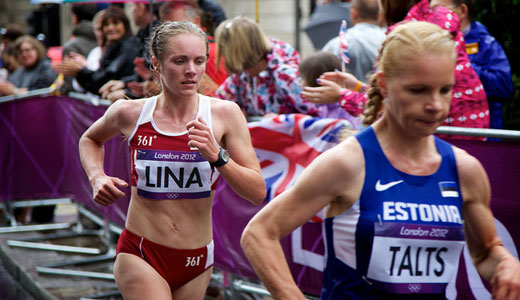
The successes of U.S. women at the 2012 London Olympics as recently profiled here are the most recent testament to the powerful impacts of Title IX since its passage. However, the London Games were also the site of positive developments for women athletes across the world.
Belinda Goldsmith of Reuters noted many of these advances: Every nation participating in the Games had at least one female athlete competing on their national team; the three largest teams – the U.S., China, and Russia – had more women than men on their Olympic squads; and female Olympians made up approximately 45 percent of the total athletes – the highest percentage in the history of the Games.
London’s Olympics was the site of these laudable developments for women’s access to and full participation in major athletic activities. However, the female contingents from a number of countries faced challenges as they prepared for, came to, and participated in the 2012 Games.
The most notable of these difficulties were the allegations of sexism lodged at the Japanese and Australian Olympic committees for their travel arrangements. The Australian women’s basketball team and the Japanese women’s soccer team were both relegated to flights in economy seating while the male teams flew in the more spacious business class seating.
This difference in treatment is even more galling when one looks at the records of these teams. The Australian women’s basketball squad has earned more medals and seen much more international success than the men’s team. The Japanese women’s soccer team was coming off winning a World Cup at the most recent FIFA tournament in 2010.
After public outrage over the Japanese flight arrangements, the women were told that they could have upgraded flights if they earned a medal at the London Games. No such arrangement was publicly made for the men. Ultimately, the women’s soccer team earned a silver medal for Japan and got moderately upgraded seating for their flight home.
There was another significant challenge that did not receive nearly as much media coverage: the limitation of opportunity, full participation, and ability to thrive successfully in international sports for women in certain countries.
Sahaf Rahimi is a 17-year-old female Afghan boxer. A combination of cultural limitations within her society and the lack of spaces to train appropriately have significantly inhibited her ability to reach her true athletic potential. During the reign of the Taliban, all women were denied access to sports and have only had a little over a decade of burgeoning access and involvement. Her father has spoken about receiving threats from conservative members of Afghan society over Rahimi’s sporting activity. Then, of course, there are the devastating effects of an over ten-year imperial occupation by U.S. military forces.
A combination of these factors has created a situation where Rahimi and her fellow boxers are fearful about their personal safety, have no ring in which they can spar, and have very limited access to training facilities – especially when compared to their Olympic counterparts from other nations. Due to all of these factors, she ultimately lost her Olympic berth over fears that she would be gravely injured in competition.
Similar limitations can be seen in the case of female athletes in Saudi Arabia. Women in the kingdom are not allowed to participate in school physical education courses, have no access to sporting club facilities/sport federations, and have not been able to access international sporting competition.
After much public pressure, the threat of banning Saudi Arabia from the 2012 Games, criticism from human rights groups, and the technical ineligibility of possible female Saudi athletes, two women – Sarah Attar and Wojdan Shaherkani – were given the opportunity to represent Saudi Arabia in the 2012 London Games.
Much like Rahimi and her fellow female athletes in Afghanistan, there was a concerted intimidation campaign waged against Shaherkani and her family including threats to the family and a Twitter campaign calling her a “prostitute” for her involvement in athletics.
Despite a possible ban from participation over the safety of wearing a sport hijab in judo competition, Shaherkani ultimately did compete at the Games in judo. Attar competed in a track event. Shaherkani was defeated in 82 seconds and Attar finished last in her heat. Yet both women were heralded for their groundbreaking status as the first female Olympians to represent Saudi Arabia.
While there were incredibly affirming events for women athletes at the London Games, we must continue to be vigilant about the underlying issues to ensure that there is fairness in treatment and that women athletes around the world are able to have equality in access, training, and participation in sports.
Photo: Women’s marathon at the 2012 Olympics. aurelien/Flickr

MOST POPULAR TODAY

High Court essentially bans demonstrations, freedom of assembly in Deep South

Zionist organizations leading campaign to stop ceasefire resolutions in D.C. area

U.S. imperialism’s ‘ironclad’ support for Israel increases fascist danger at home


UN warns that Israel is still blocking humanitarian aid to Gaza






Comments